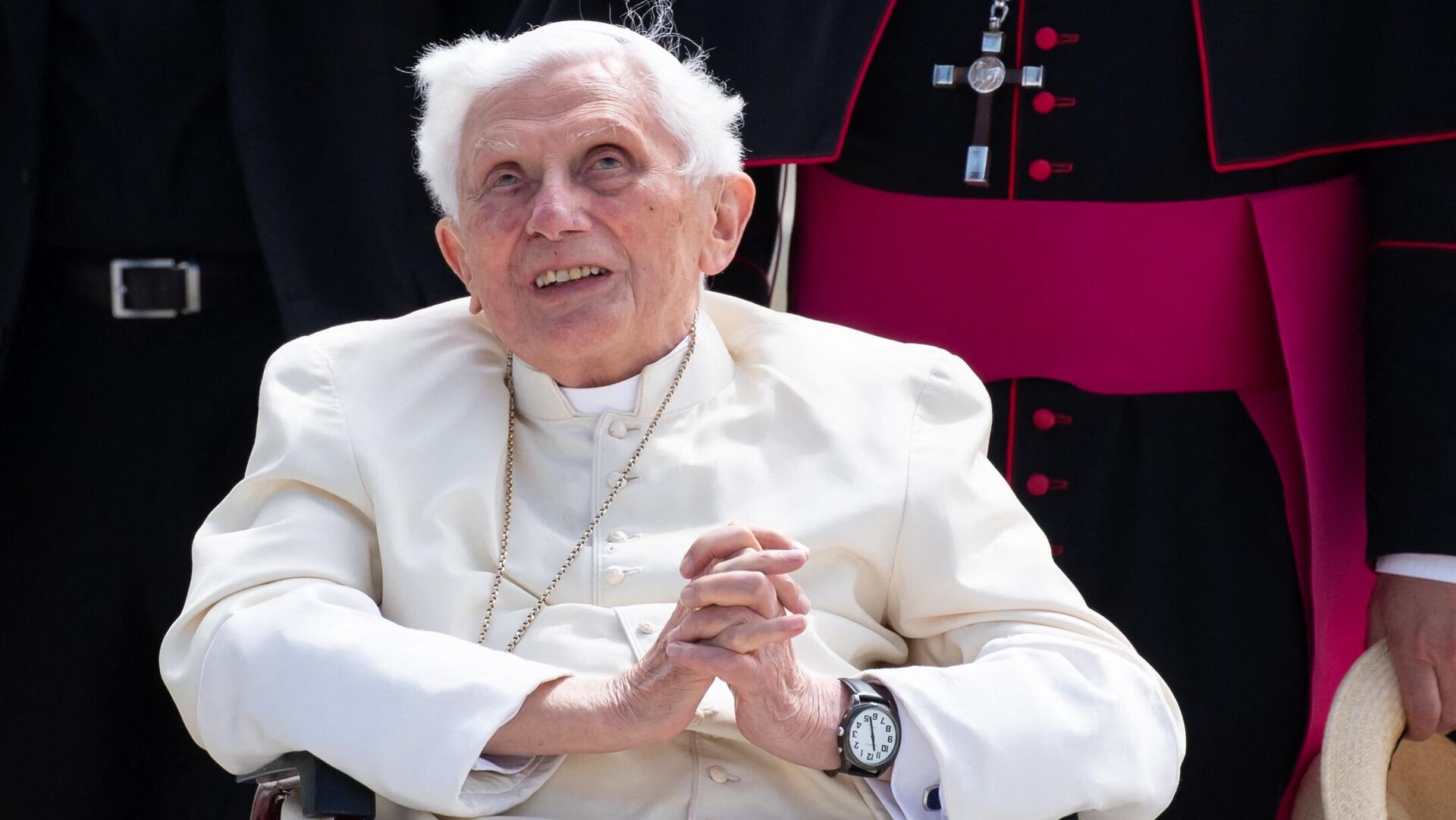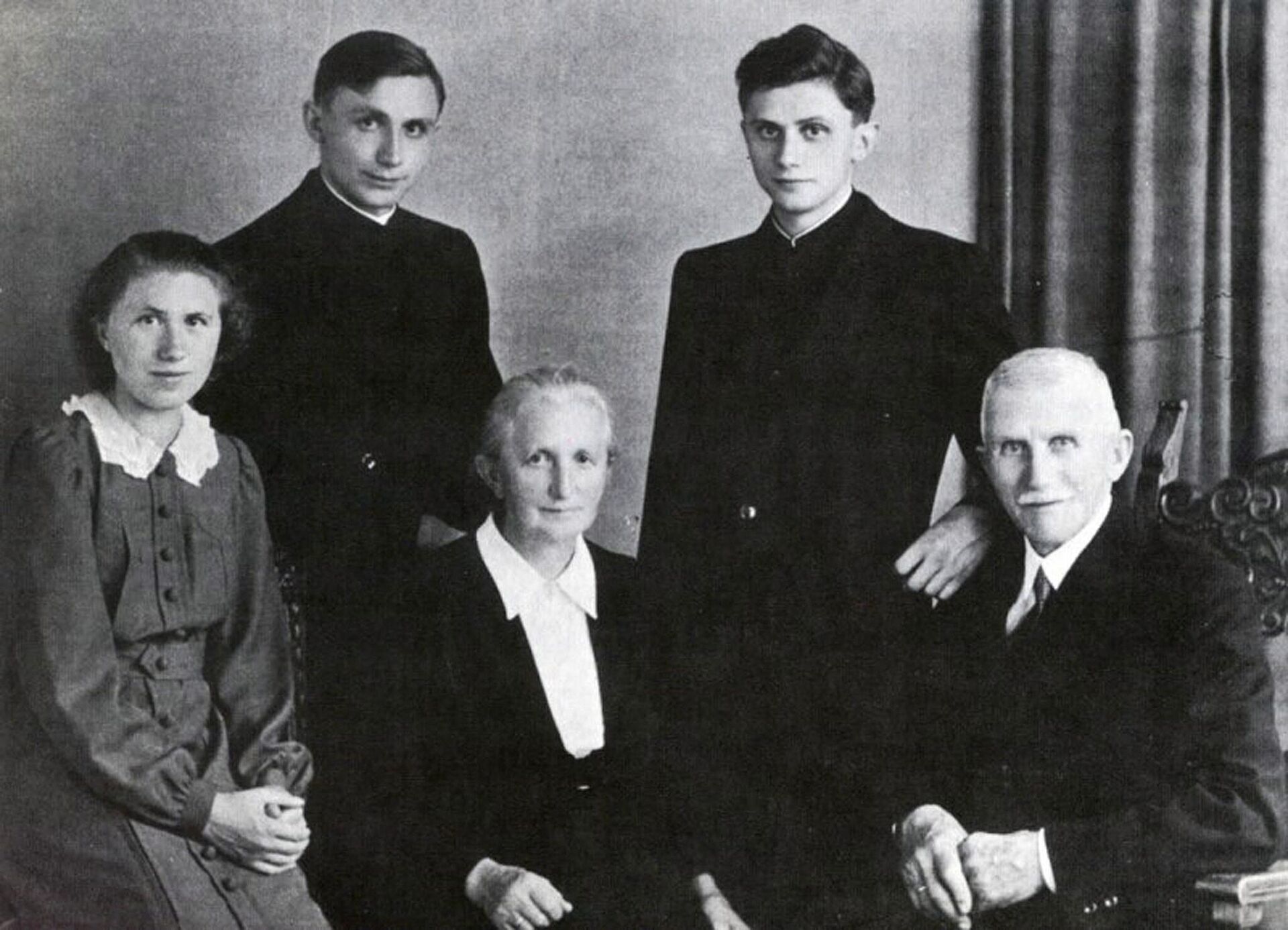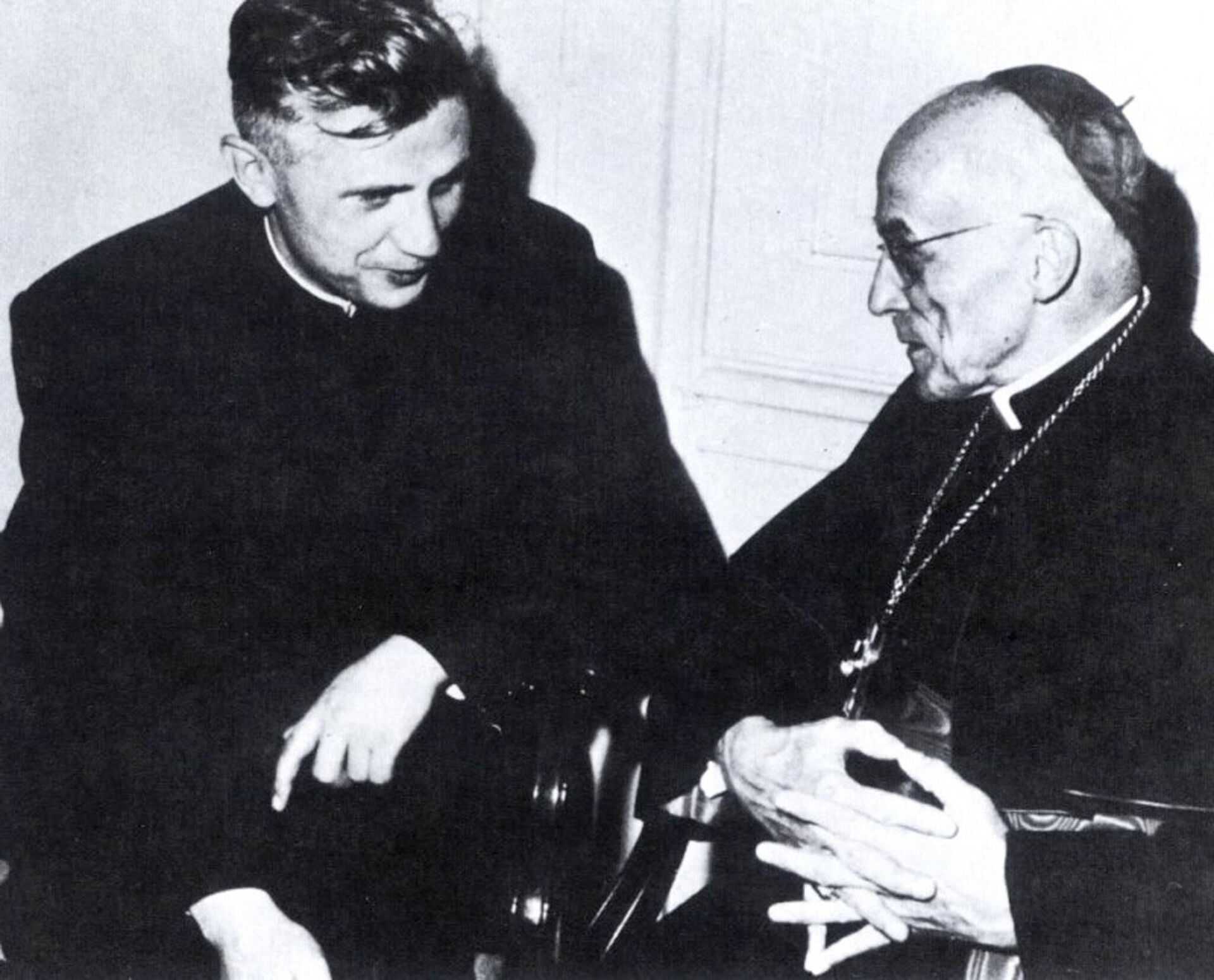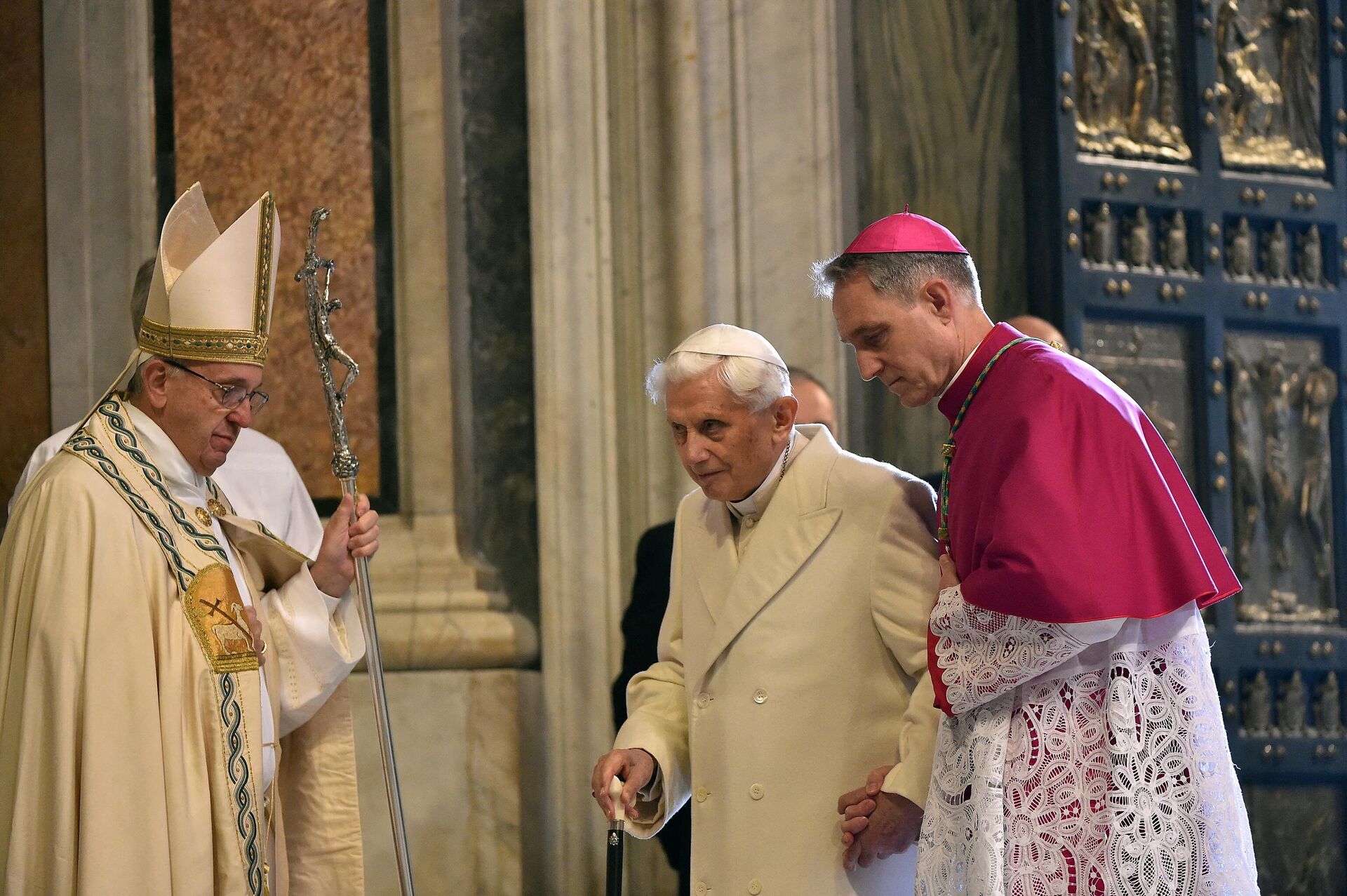From Hitler Youth to Papacy: Life and Legacy of Pope Emeritus Benedict XVI

© AFP 2023 / SVEN HOPPE
Subscribe
His Holiness Pope Emeritus Benedict XVI, the 265th leader of the Roman Catholic Church, has passed away at the age of 95.
Benedict retired from his role as Bishop of Rome in February 2013, saying he was unable to fulfill the duties of his office because of a "lack of strength of mind and body" due to his advanced age. He had served in the role for eight years, and was succeeded by Pope Francis I, the current pontiff.
Benedict was born Joseph Aloisius Ratzinger on April 16, 1927, in the Bavarian town of Marktl, in southeastern Germany. He was the third and youngest of the three children of Joseph Ratzinger Sr., a police officer, and Maria Ratzinger. At the age of five, Benedict knew he wanted to become a cardinal after becoming fascinated by the vestments of the Cardinal Archbishop of Munich during a visit to their small town.

This photo taken on January 1951 shows the family of Josef Ratzinger (up, R) in Freising, Bavaria, after the ordination of himself and his brother Georg (up L). Germany's Cardinal Joseph Ratzinger was elected the 265th pope of the Roman Catholic Church on 19 April 2005 and took the name Benedict XVI, the Vatican announced. Bottom row : his sister Maria, his Mother Maria and his father Josef.
© AFP 2023 / Roman Catholic Archdiocese of Munich and Freising
After the Nazi seizure of power, Benedict’s father suffered a demotion due to his opposition to fascist rule, but after Benedict turned 14 in 1941, he was compulsorily drafted into the Hitler Youth. He was recorded as an "unenthusiastic member." Two years later, he was drafted into an anti-air artillery corps, then trained as infantry, but deserted his post in 1945 as American forces approached. He was briefly interned in a prisoner-of-war camp until being released at the end of the war.
Later that year, Benedict and his older brother, George, enrolled at Saint Michael Seminary in Traunstein, and later at the Ducal Georgianum seminary at Ludwig-Maximilian University in Munich. They were both ordained in 1951 by Cardinal Michael von Faulhaber – the same cardinal whose robes had drawn him to the clergy as a child.
In 1953, he completed his Phd., with his thesis on St. Augustine and the Church, and four years later, he qualified as a university professor. Benedict variously taught theology at Freising, Bonn, Münster, Tübingen, and Regensberg.

This file photo taken on January 1962 shows Josef Ratzinger (L), then professor of theology with Cologne's Cardinal Joseph Frings who took him as an advisor to the council at the Vatican. Germany's Cardinal Joseph Ratzinger was elected the 265th pope of the Roman Catholic Church on 19 April 2005 and took the name Benedict XVI.
© AFP 2023 / Roman Catholic Archdiocese of Munich and Freising
From 1962 until 1965, Benedict participated in the Second Vatican Council, a vast ecumenical meeting that overhauled much of Catholic doctrine, updating it for 20th century needs. This included holding Mass in the vernacular tongue instead of Latin, and, in the wake of the Holocaust, dropped liturgical references to Jews being the killers of Christ. He served as theological consultant to Cardinal Frings of Cologne. Benedict became an especially strong promoter of the principle of "ecumenical dialogue" between the Catholic Church and other religions, and the respect of other faiths.
In 1977, Benedict was ordained as a bishop when he was appointed Archbishop of Munich and Freising, as well as Cardinal Priest of Santa Maria Consolatrice al Tiburtino by Pope Paul VI.
Three years later, he was elevated to become Prefect of the Sacred Congregation for the Doctrine of the Faith – formerly, the Roman Inquisition – and began to climb the ranks of the College of Cardinals.
In 1998, an asteroid was named 8661 Ratzinger in his honor for his role in supervising the opening of the Vatican Archives to researchers investigating judicial errors against the 17th century astronomer Galileo Galilei and other scientists.
When Pope John Paul II died in April 2005, it triggered the meeting of a new conclave, and Benedict was elected to become the next Supreme Pontiff.

In this photograph taken on April 8, 2005, German Cardinal Joseph Ratzinger blesses the coffin of Pope John Paul II during his funeral mass on St Peter's Square at The Vatican City.
© AFP 2023 / PATRICK HERTZOG
At age 78, he was the oldest person elected to the office since 1730, and he was the second consecutive non-Italian Pope since the 14th century scandal known as the Avignon Papacy, when the Papacy temporarily relocated to France. It was at this point that he adopted the name Benedict XVI, the previous Benedict having served in the early 20th century.
During the conclave, which was held in the Sistine Chapel, Benedict was almost universally seen as the most logical choice to succeed John Paul II, but he ironically did not want to serve as Pontiff.
"At a certain point, I prayed to God 'please don't do this to me,'" Benedict later recalled. "Evidently, this time He didn't listen to me."
Although Benedict was seen as a reformer, embracing Vatican II, ushering in changes intended to bring him closer to the masses, and de-emphasizing the importance of the Papal office, he was also an opponent of liberal movements and blamed what he called "moral relativism" and secularism for the major problems of the 21st century. He also permitted continued use of the Tridentine Mass, the pre-1962 Latin text that was edited and translated at Vatican II, in an attempt to avoid a schism in the Church.
While Benedict was head of the Congregation for the Doctrine of the Faith, he convinced John Paul II to put sexual abuse investigations under the CDF's purview, and rigorously prosecuted investigations against accused clergy. He also pioneered several changes to canon law, expanding the scope of potential crimes and establishing a fast-track dismissal process for clergy. As Pope, Benedict continued this drive, but was nonetheless still faulted for several high-profile abuse cases that failed to result in dismissal, as well as an embarrassing uncovering of his own overlooking of abuse allegations against clergy years earlier, when he was the Archbishop of Munich and Freising.

Pope Emeritus Benedict XVI (C) is helped by the prefect of the papal household Georg Gaenswein (R) to pass the "Holy Door" as Pope Francis (L) looks on, on December 8, 2015 in Vatican.
© AFP 2023 / ALBERTO PIZZOLI
Benedict's announcement in February 2013 that he would retire as Pontiff for health reasons was sudden, but perhaps should not have been unexpected. He was already hesitant to assume the office, having suffered a hemorrhagic stroke in 1991 and having a pacemaker installed in early 2005. He was the first Pope to resign since Gregory XII in 1415, and the first to resign without duress since Celestine V in 1294.
Upon retirement, Benedict adopted the title "Pope Emeritus," and continued to be referred to as His Holiness. He moved into the renovated Mater Ecclesiae Monastery in the Vatican Gardens. However, he did not live a cloistered life, but continued to write and speak, including appearing several times with his successor, Pope Francis I. He was known to be suffering from high blood pressure, but the Vatican declined to give details, although it was later revealed that he had an inflammation of the trigeminal nerve, a facial nerve responsible for sensations in the face and for use of the jawbone.
As a member of the Catholic clergy, Benedict never married and has no known offspring. Both his brother Georg and sister Maria have also died, in 2020 and 1991, respectively, and neither married or had children.



